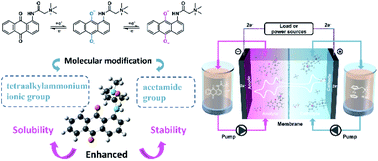Anthraquinone-based electroactive ionic species as stable multi-redox anode active materials for high-performance nonaqueous redox flow batteries†
Abstract
Anthraquinone (AQ)-based materials are promising active materials for aqueous redox flow batteries (ARFBs) owing to their fast kinetics and reversible two-electron redox reactions, but their application in non-aqueous RFBs (NARFBs) is limited by the low solubility and inferior stability of the charged species in aprotic solvents. Here, three AQ-based electroactive ionic species are purposely designed for NARFBs by incorporating the acetamide group and tetraalkylammonium ionic group into the anthraquinone structure and pairing with hydrophobic counter anions. Both experimental and theoretical calculation results show improved solubility and stability. A two-electron transfer redox flow battery with a mixed-reactant electrolyte delivers impressive cycling performance with an average coulombic efficiency of 96.8%, energy efficiency of 82.4%, and overall discharge capacity retention of 86.0% over 200 cycles (99.93% capacity retention per cycle) at 10 mA cm−2. Furthermore, the battery exhibits robust rate capability to bear the current fluctuation.



 Please wait while we load your content...
Please wait while we load your content...